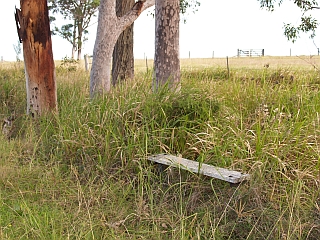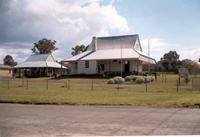This area is known as Glen Martin. A short drive from the town
of Clarence Town there are some lovely places to live in this area.
As you drive around here the views are great.
This little seat was constructed by a local for his two girls to
sit on while waiting for the school bus. All the local kids are
grown up now so the little seat gets very little use these
days.

Clarence Town
A small and pleasant town on the northern edge of the Hunter
Valley District Clarence Town is a small, pleasant, sprawling and
tranquil township picturesquely situated by the banks of the
Williams River, 204 km north of Sydney and 50 km north of
Newcastle. When the river system was the main mode of transport
within Australia, Clarence Town, being located at the Williams
River's head of navigation, was a busy and important river port.
Until the railway arrived it was effectively the gateway to
northern New South Wales - a river trip from Newcastle taking about
five hours.
The area around Clarence Town was once inhabited by the Gringgai
clan of the Wanaruah people. The first Europeans to investigate the
area were Lieutenant - Colonel Paterson (then Lieutenant Governor
of NSW) and explorer Francis Barrellier who was in the area to
conduct a survey of the harbour in Newcastle. They explored the
Hunter River and its tributaries following what they took to be the
Hunter to its navigable limit. Governor King named the river in
(William) Paterson's honour. A cedar getters camp was later
established here and a village was in existence by 1826.
Clarence Town was initially known as Erringhi. Presumably the
Aboriginal name for the site, it is thought to mean 'place of wild
ducks'. The settlement was situated at what is now the southern end
of town by the Williams River where there was a wharf and where
William Lowe and James Marshall established the Deptford Shipyards
in 1830. Clarence Town's main claim to fame was that this was the
spot where, in 1831, Australia's first ocean-going paddle steamer
(called the William IV) was built and launched.
Marshall and Lowe produced many vessels over the years, mostly
under 50 tons, reaching a commercial peak in the 1870s and closing
in the 1890s. Some of the steamers used on the Sydney to Morpeth
run were also built here.
The village was renamed in 1832 after the Duke of Clarence (who
became King William IV in 1830). A prosperous town by mid-century
it was much bigger than Dungog. Timber was loaded here for
international destinations. By the 1880s dairying, grazing and
fodder production had become the town's economic mainstays and they
remain so to this day.
Following on from the general economic depression of the 1890s
floods hit for four consecutive years and a fire destroyed much of
the town. When the railway arrived in 1911 Clarence Town was
bypassed and its importance as a centre of exchange vanished.
Want to know more about Clarence Town and environs:
Clarence Town

Clarence Town Museum in the former
Courthouse
